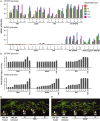Allele exchange at the EPSPS locus confers glyphosate tolerance in cassava
- PMID: 29223136
- PMCID: PMC5999311
- DOI: 10.1111/pbi.12868
Allele exchange at the EPSPS locus confers glyphosate tolerance in cassava
Abstract
Effective weed control can protect yields of cassava (Manihot esculenta) storage roots. Farmers could benefit from using herbicide with a tolerant cultivar. We applied traditional transgenesis and gene editing to generate robust glyphosate tolerance in cassava. By comparing promoters regulating expression of transformed 5-enolpyruvylshikimate-3-phosphate synthase (EPSPS) genes with various paired amino acid substitutions, we found that strong constitutive expression is required to achieve glyphosate tolerance during in vitro selection and in whole cassava plants. Using strategies that exploit homologous recombination (HR) and nonhomologous end-joining (NHEJ) DNA repair pathways, we precisely introduced the best-performing allele into the cassava genome, simultaneously creating a promoter swap and dual amino acid substitutions at the endogenous EPSPS locus. Primary EPSPS-edited plants were phenotypically normal, tolerant to high doses of glyphosate, with some free of detectable T-DNA integrations. Our methods demonstrate an editing strategy for creating glyphosate tolerance in crop plants and demonstrate the potential of gene editing for further improvement of cassava.
Keywords: cassava; gene editing; gene replacement; herbicide tolerance.
© 2017 The Authors. Plant Biotechnology Journal published by Society for Experimental Biology and The Association of Applied Biologists and John Wiley & Sons Ltd.
Conflict of interest statement
The authors have no conflict of interest to declare. AWH, RDC, RB, DFV and NJT are inventors on a patent application (PCT/US2017/013208) for the technology described in this work.
Figures



References
-
- Bredeson, J.V. , Lyons, J.B. , Prochnik, S.E. , Wu, G.A. , Ha, C.M. , Edsinger‐Gonzales, E. , Grimwood, J. et al. (2016) Sequencing wild and cultivated cassava and related species reveals extensive interspecific hybridization and genetic diversity. Nat. Biotechnol. 34, 562–570. - PubMed
-
- Chauhan, R.D. , Beyene, G. , Kalyaeva, M. , Fauquet, C.M. and Taylor, N. (2015) Improvements in Agrobacterium‐mediated transformation of cassava (Manihot esculenta Crantz) for large‐scale production of transgenic plants. Plant Cell Tissue Organ Cult. 121, 591–603.
Publication types
MeSH terms
Substances
Associated data
- Actions
LinkOut - more resources
Full Text Sources
Other Literature Sources

